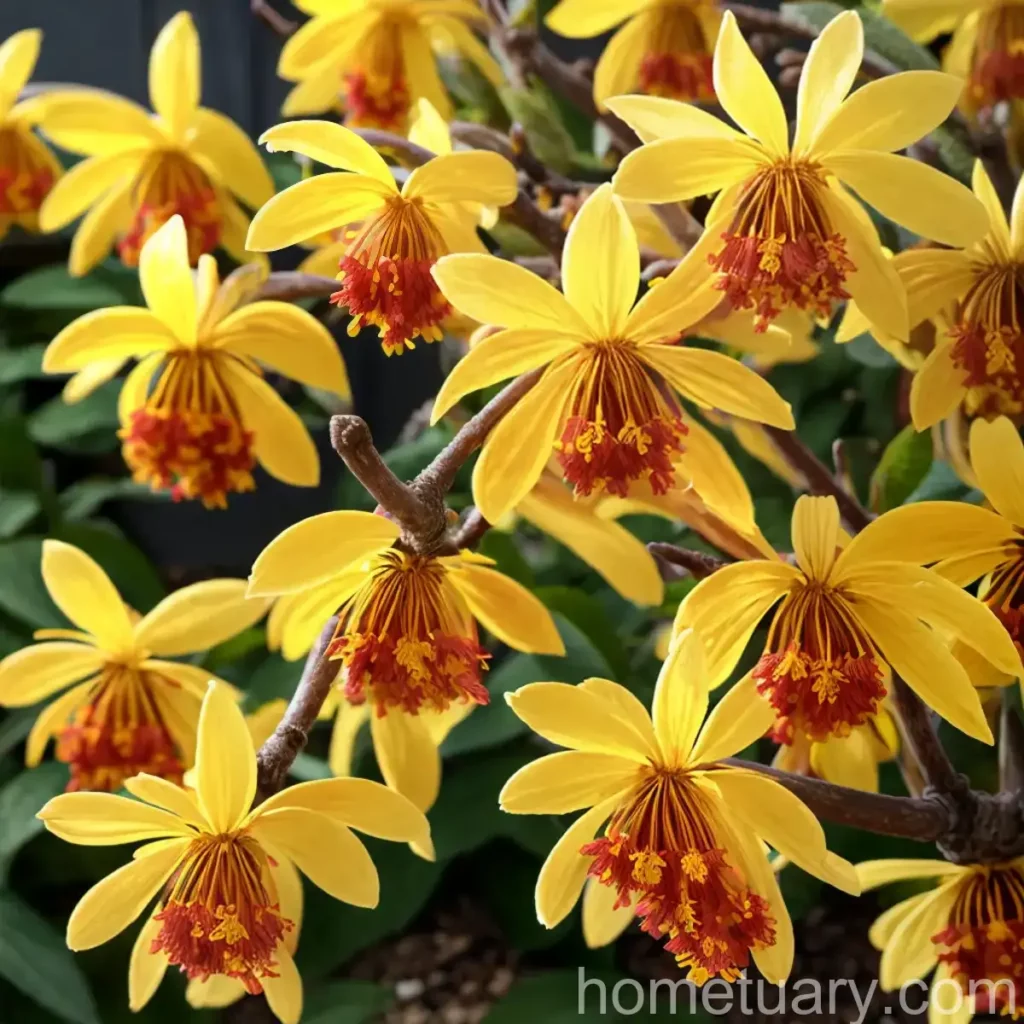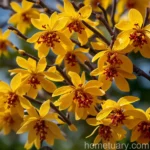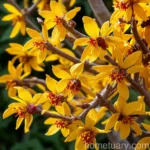Witch Hazel (Hamamelis x intermedia ‘Primavera’)
Witch hazel, scientifically known as Hamamelis x intermedia ‘Primavera,’ is a beautiful and versatile plant with a rich history of traditional uses and modern applications. This winter-blooming shrub produces fragrant flowers and serves as a valuable addition to gardens and landscapes. In this comprehensive guide, we will explore the diverse aspects of witch hazel, including its culture, uses, care requirements, common diseases, and pest management. Additionally, we will delve into the plant’s propagation, its adaptability to containers, and provide valuable tips for enthusiasts and botanists. Let’s embark on an engaging journey into the world of witch hazel!
What is Witch Hazel?
Witch hazel is a flowering shrub belonging to the Hamamelidaceae family. The plant is known for its striking flowers, which bloom during the winter months, bringing a burst of color and fragrance to the garden when most other plants are dormant. The botanical name Hamamelis x intermedia ‘Primavera’ showcases the hybrid nature of this particular variety, resulting from the crossbreeding of different Hamamelis species. Witch hazel is renowned for its exceptional ornamental value, distinctive foliage, and unique medicinal properties, making it a prized addition to landscapes and gardens.
Key Takeaways – Witch Hazel (Hamamelis x intermedia ‘Primavera’)
- Winter-blooming shrub with fragrant flowers
- Versatile uses in landscaping, herbal medicine, and skincare
- Resilient and adaptable to various environmental conditions
- Hybrid variety resulting from Hamamelis species crossbreeding
- Rich cultural and historical significance
Now, let’s delve deeper into the specific aspects of witch hazel, including its culture, uses, and essential care requirements.
Culture
Cultivating witch hazel is a rewarding experience for plant enthusiasts due to its undemanding nature and exquisite beauty. Understanding the specific cultural requirements of this shrub is essential for ensuring its optimal growth and overall health.
Water
Witch hazel (Hamamelis x intermedia ‘Primavera’) exhibits moderate water needs and prefers moist, well-draining soil. During the initial establishment phase, regular watering is essential to promote healthy root development. However, once established, witch hazel is relatively drought-tolerant and can thrive without excessive irrigation. It is crucial to strike a balance in watering to prevent waterlogging, especially in clay-rich soils, which may lead to root rot and other moisture-related issues.
Sunlight
In terms of sunlight requirements, witch hazel thrives in partial to full sun exposure. When planted in a garden or landscape, consider a location that receives ample sunlight during the day, ensuring the plant’s access to necessary light for photosynthesis and flower production. While it can tolerate partial shade, providing adequate sunlight promotes robust growth and profuse flowering, enhancing the overall ornamental appeal of the shrub.
Fertilizer
Witch hazel typically does not have high fertilizer requirements and can thrive in moderately fertile soils. Applying a balanced, slow-release fertilizer in early spring can support healthy growth and flowering. It is advisable to avoid over-fertilization, as excessive nutrients can lead to lush foliage growth at the expense of flower production. Regularly amending the soil with organic matter, such as compost, can contribute to long-term soil fertility and the overall well-being of the plant.
Soil
The ideal soil for witch hazel cultivation is well-draining, loamy, and slightly acidic. A pH range of 5.5 to 6.5 is optimal for ensuring nutrient uptake and overall plant health. Additionally, witch hazel exhibits excellent adaptability to various soil types, including sandy and clay soils, as long as they offer adequate drainage. Amending the soil with organic matter can enhance its structure and fertility, creating an optimal growing environment for the shrub.
Uses
Witch hazel (Hamamelis x intermedia ‘Primavera’) is valued for a wide range of uses, spanning from landscaping to medicinal and skincare applications. Understanding the diverse uses of this versatile shrub allows enthusiasts to fully appreciate its multifaceted contributions.
-
Landscaping: In garden and landscape design, witch hazel serves as an enchanting addition, especially during the winter season when its vibrant flowers provide a captivating display. Its graceful form and colorful blooms make it a valuable feature in both residential and public gardens, contributing to the overall aesthetic appeal of outdoor spaces.
-
Herbal Medicine: Witch hazel has a long history of traditional medicinal uses, particularly in herbal medicine. The plant’s bark, twigs, and leaves contain tannins and other bioactive compounds that offer astringent, anti-inflammatory, and antioxidant properties. Witch hazel extracts and preparations have been used to address various skin conditions, alleviate discomfort, and promote overall skin health.
-
Skincare: Modern skincare products often incorporate witch hazel extracts for their astringent and soothing properties. From toners and cleansers to ointments and creams, witch hazel serves as a natural ingredient in formulations designed to address acne, inflammation, and other dermatological concerns. Its gentle yet effective nature has made it a popular choice in natural skincare routines.
Pruning
Pruning is an essential aspect of witch hazel care, contributing to the plant’s vigor, shape, and flowering performance. Proper pruning techniques are crucial for maintaining the shrub’s health and promoting abundant blooms.
-
Timing: The ideal time for pruning witch hazel is after the flowering period, typically in late spring or early summer. This timing allows for the removal of spent flowers and the shaping of the plant without compromising the formation of future flower buds.
-
Pruning Objectives: When pruning witch hazel, focus on removing dead, damaged, or diseased branches, as well as crowded or crossing stems. This enhances air circulation within the plant and reduces the risk of disease. Additionally, selective pruning can help maintain the desired shape and size of the shrub while stimulating new growth and flowering potential.
-
Techniques: Utilize sharp, clean pruning tools to make precise cuts, minimizing any potential damage to the plant. Aim for strategic pruning that encourages an open and balanced growth habit. Careful consideration of the overall structure and natural form of the shrub is essential to achieve a harmonious and visually appealing result.
Propagation
Propagating witch hazel allows enthusiasts to expand their plant collection and share the beauty of this remarkable shrub with others. Several methods can be employed to propagate witch hazel successfully.
-
Seed Propagation: While viable seeds can be collected from mature witch hazel fruits, the germination process can be challenging, requiring specific environmental conditions and a lengthy period for the seeds to sprout. As a result, seed propagation may not be the preferred method for promptly obtaining new plants.
-
Softwood Cuttings: Propagating witch hazel from softwood cuttings in early summer presents a viable and relatively successful method. Take cuttings from young, healthy branches, and provide appropriate rooting conditions, such as a moist medium and consistent humidity, to facilitate the development of new roots.
-
Layering: Air layering is another propagation technique that can yield new witch hazel plants. By inducing the formation of roots on a selected stem while it remains attached to the mother plant, layering offers a method of creating genetically identical offspring with established roots, enhancing their survival upon separation.
-
Grafting: The propagation of witch hazel through grafting involves joining a scion (desired witch hazel variety) onto a compatible rootstock. This method allows for the production of uniform and well-established plants with desired characteristics, offering an efficient means of reproducing specific witch hazel cultivars.
Container Popularity
Witch hazel’s adaptability to container cultivation has made it a popular choice for enthusiasts with limited garden space or those seeking to create captivating displays on patios, balconies, and other urban settings.
-
Container Selection: When choosing containers for witch hazel, opt for spacious, sturdy pots with adequate drainage holes. Selecting containers that accommodate the plant’s root system and promote proper aeration and drainage is essential for its long-term health and vitality.
-
Growing Medium: Utilize a well-draining, high-quality potting mix tailored to woody ornamental plants. Consider adding organic matter, such as compost or aged bark, to enhance the soil structure and fertility.
-
Placement: Position witch hazel containers in locations that receive ample sunlight, ensuring that the plant can thrive and flower successfully. Regular monitoring of moisture levels and appropriate watering practices are crucial when growing witch hazel in containers, as the soil may dry out more rapidly than in-ground plantings.
-
Overwintering: In cold climates, container-grown witch hazel may require additional protection during the winter months. Consider providing insulation or relocating the containers to shielded areas to safeguard the plants from harsh weather conditions.
Common Diseases
While witch hazel (Hamamelis x intermedia ‘Primavera’) is relatively resilient, it is vulnerable to certain diseases and environmental stressors. Recognizing common diseases and adopting preventive measures is essential for maintaining the plant’s health and vitality.
Disease Diagnosis
-
Powdery Mildew: The presence of powdery white patches on the leaves and shoots may indicate a powdery mildew infestation. This fungal disease can affect witch hazel, particularly in humid and crowded growing conditions. Adequate spacing, proper ventilation, and the removal of affected plant parts can help manage powdery mildew.
-
Leaf Spot: Leaf spot diseases, characterized by dark spots or lesions on the foliage, can impact witch hazel’s aesthetic appeal and overall vigor. Promoting good air circulation, avoiding overhead watering, and practicing proper sanitation are crucial for preventing the spread of leaf spot pathogens.
-
Botrytis Blight: Botrytis blight, caused by the Botrytis cinerea fungus, can lead to the development of gray, fuzzy mold on witch hazel flowers and buds. Ensuring proper air circulation, reducing excess moisture, and promptly removing affected plant material can mitigate the impact of Botrytis blight.
Common Pests
Witch hazel may also face challenges from various pests that can affect its growth and flowering potential. Understanding common pests and implementing targeted pest management strategies is essential for preserving the plant’s health.
-
Aphids: These small, sap-sucking insects can cluster on witch hazel foliage, causing distorted growth and the secretion of sticky honeydew. Natural predators, such as ladybugs and lacewings, can help control aphid populations. Additionally, gently spraying the foliage with water can dislodge aphids from the plant.
-
Scale Insects: Scale insects may appear as immobile, waxy bumps on witch hazel branches, where they feed on plant sap. Pruning infested branches and applying horticultural oil during the dormant season can help manage scale insect populations and prevent their spread.
-
Spider Mites: Spider mites, characterized by tiny webs on the foliage and stippled discoloration, can impact witch hazel, particularly in dry and warm conditions. Rinsing the plant with water and maintaining adequate humidity levels can deter spider mite infestations.
Botanist’s Tips
As a plant scientist specializing in witch hazel, I have accumulated valuable tips and insights for enthusiasts and botanists seeking to cultivate and appreciate this exceptional shrub.
-
Observation: Regularly observe your witch hazel plant throughout the seasons, noting its growth patterns, flowering habits, and any signs of stress or pest activity. Understanding the plant’s natural behavior is essential for providing tailored care and addressing potential issues.
-
Early Intervention: Promptly address any signs of disease, pest infestations, or environmental stress affecting witch hazel. Early intervention can significantly contribute to the plant’s resilience and long-term health.
-
Cultural Practices: Implement cultural practices such as mulching, adequate watering, and appropriate pruning to promote the overall well-being of witch hazel. Consistent care and attention to the plant’s needs can yield rewarding results.
-
Education and Engagement: Engage with fellow enthusiasts, local botanical gardens, and horticultural societies to expand your knowledge of witch hazel and exchange growing tips and experiences. Learning from others and sharing your insights can enrich the collective understanding of this remarkable plant.
Fun Facts
Witch hazel is a plant with a rich history, diverse uses, and fascinating botanical characteristics. Here are some intriguing fun facts about this captivating shrub:
-
The name “witch hazel” is believed to originate from the Middle English term “wiche,” meaning pliant or bendable, alluding to the plant’s flexible branches.
-
Witch hazel extract has been traditionally used by Native American tribes for various medicinal applications, ranging from skin remedies to digestive aids.
-
Witch hazel’s distinctive flowers, which appear in late winter to early spring, provide a vital food source for pollinators during the colder months when floral resources are scarce.
-
The astringent properties of witch hazel bark and leaves have been harnessed for generations, offering a natural solution for minor cuts, insect bites, and skin irritations.
-
Witch hazel’s autumn foliage displays vibrant shades of yellow, orange, and red—a stunning prelude to the winter bloom of its fragrant flowers.
Links to External Resources
To further enrich your understanding of witch hazel and explore additional insights, resources, and references, consider the following external links:
-
The American Witch Hazel Society: A comprehensive resource for witch hazel enthusiasts, offering information on cultivation, varieties, and historical significance.
-
Royal Horticultural Society – Witch Hazel: An in-depth guide to growing and caring for witch hazel, including specific cultivation advice and best practices.
-
National Institute of Food and Agriculture – Hamamelis Species: Information on the botanical characteristics and horticultural potential of different Hamamelis species, including insights into hybrid varieties like Hamamelis x intermedia ‘Primavera.’
-
University of Maryland Medical Center – Witch Hazel: An overview of traditional and modern medicinal uses of witch hazel, including its applications in skincare, wound healing, and natural remedies.
-
The Wildlife Trusts – Witch Hazel: An exploration of witch hazel’s ecological significance and its role as a valuable resource for wildlife and pollinators.
With its captivating flowers, rich cultural heritage, and diverse applications, witch hazel (Hamamelis x intermedia ‘Primavera’) stands as an exceptional representative of the botanical world. Whether incorporated into garden landscapes, utilized in herbal remedies, or admired for its ornamental charm, this versatile shrub continues to captivate and inspire individuals with its enduring allure.
By sharing insights into the cultivation, uses, and botanical characteristics of witch hazel, this comprehensive guide serves as an invaluable resource for plant enthusiasts, botanists, and individuals intrigued by the natural world. Embrace the enchanting world of witch hazel and discover the beauty and versatility of this extraordinary plant.
We hope you enjoyed this immersive journey into the realm of witch hazel, uncovering its secrets, applications, and timeless allure. Happy planting and may your gardens flourish with the enchanting presence of witch hazel!
Disclaimer: The information provided in this article is for educational purposes and does not constitute professional medical or skincare advice. Always consult with a qualified healthcare or skincare professional before using plants or plant-derived products for medicinal or skincare purposes.















